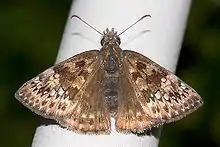Erynnis horatius
Erynnis horatius, the Horace's duskywing, is a butterfly of the family Hesperiidae. It is found from Massachusetts, west to eastern South Dakota, south through most of the eastern United States to Florida, the Gulf Coast, and southern Texas, south in the west through south-eastern Utah, Colorado, north-eastern Arizona, and New Mexico. It is listed as a species of special concern in the US state of Connecticut.[2]
| Horace's duskywing | |
|---|---|
 | |
| Female | |
 | |
| Male | |
| Scientific classification | |
| Kingdom: | |
| Phylum: | |
| Class: | |
| Order: | |
| Family: | |
| Tribe: | |
| Genus: | |
| Species: | E. horatius |
| Binomial name | |
| Erynnis horatius (Scudder & Burgess, 1870) | |
| Synonyms | |
| |
Fringes are brown. Upperside of male forewing is dark brown with little contrast and no white overscaling. Upperside of female forewing is light brown with a contrasting pattern and large transparent spots. Underside of hindwing is usually without two spots below the apex. The male has a costal fold containing yellow scent scales; the female has a patch of scent scales on the 7th abdominal segment. The wingspan is 36–49 mm.
There are two generations in the north, with adults on the wing from April to September; there are three generations in the deep south and Texas, with adults on the wing from January to November. Adults prefer open woodlands and edges, clearings, fence rows, wooded swamps, power-line right-of-ways, open fields and roadsides
Caterpillars are hosted by both red and white oaks including willow oak (Quercus phellos), northern red oak (Q. velutina), scrub oak (Q. ilicifolia), water oak (Q. nigra), post oak (Q. stellata), and live oak (Q. virginiana). Adults consume nectar from flowers up to about 4.5 feet tall, including dogbane, buttonbush, sneezeweed, goldenrod, peppermint, boneset, and winter cress.[3]
References
- "Erynnis horatius Horace's Duskywing". Retrieved 27 September 2020.
- "Connecticut's Endangered, Threatened and Special Concern Species 2015". State of Connecticut Department of Energy and Environmental Protection Bureau of Natural Resources. Retrieved January 27, 2018.
- https://www.butterfliesandmoths.org/species/Erynnis-horatius
External links
- Erynnis horatius - Horace's Duskywing, BugGuide
- Erynnis horatius, Butterflies and Moths of North America
- Horace's Duskywing, Massachusetts Butterfly Club
- Horace's Duskywing, Butterflies of Canada
